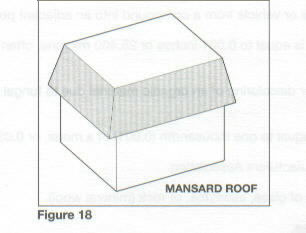Glossary of Roofing and Waterproofing Terms
M
A B C D E F G H I JK L M N OP R S T UV W-Z
Mansard: a decorative steep-sloped roof on the perimeter of a building.
Mansard Roof: a steeper roof that terminates into a flat roof at its high point. (See Figure 18.)
Masonry: anything constructed of such materials as bricks, stone, concrete blocks, ceramic blocks, or concrete.
Mastic: see Asphalt Roof Cement.
Mat: a thin layer of woven, non-woven, or knitted fiber that serves as reinforcement to the material or membrane.
Mat Slab: a concrete slab designed with reinforcement to resist the uplift forces created by hydrostatic pressure.
Material Safety Data Sheets (MSDS): a written description of the chemicals in a product, and pertinent other data including such things as safe handling and emergency procedures. In accordance with OSHA regulations, it is the manufacturer's responsibility to produce an MSDS and the employer's responsibility to communicate its contents to employees.
MBDA: formerly Metal Builders Dealers Association, now Systems Builders Association.
MBMA: Metal Building Manufacturers Association
MCA: Metal Construction Association
Mechanically-Fastened Membranes: generally used to describe membranes that have been attached at defined intervals to the substrate. Mechanical fastening may be performed with various fasteners and/or other mechanical devices, such as plates or battens.
Membrane: a flexible or semi-flexible material, which functions as the waterproofing component in a roofing or waterproofing assembly, and whose primary function is the exclusion of water.
Metal Film: a layer of foil made from a single metallic substance, or from an alloy, that is laminated to a membrane during manufacture. The metal foil serves as the weathering surface of the membrane or flashing material.
Metal Flashing: accessory components fabricated from sheet metal and used to weatherproof terminating roof covering edges. Frequently used as through-wall flashing, cap flashing (coping), counterflashing, stepflashing, etc. (See Flashing.)
Metallic Waterproofing: a compound modified through the inclusion of one or more polymers (e.g. atactic polypropylene, styrene butadiene sytrene, etc.); (2) composite sheets consisting of a polymer modified bitumen often reinforced and sometimes surfaced with various types of mats, films, foils, and mineral granules.
Meter: unit of length measurement in the metric system, equal to 39.37 inches.
Mica Dust: crystallized complex silicate minerals that are pulverized into dust form for use as a release agent. (See Talc.)
Microbiological Resistance: the ability of a material to resist attack and degradation by various air- and soilborne micro-organisms.
Migration: the absorption of oil or vehicle from a compound into an adjacent porous surface.
Mill: a unit of measure, one mil is equal to 0.001 inches or 25.400 microns, often used to indicate the thickness of a roofing membrane.
Mildew: a superficial coating or discoloring of an organic material due to fungal growth, especially under damp conditions.
Millimeter: a unit of measure equal to one thousandth (0.001) of a meter, or 0.03937 inches.
MIMA: Mineral Insulation Manufacturers Association
Mineral Fiber: inorganic fibers of glass, asbestos, or rock (mineral wool).
Mineral Granules: see Granules.
Mineral Stabilizer: a fine, water-insoluble inorganic material, used in a mixture with solid or semi-solid hit'~minous materials.
Mineral-Surfaced Roofing: roofing materials whose surface or top layer consists of mineral granules.
Mineral-Surfaced Sheet: a roofing sheet that is coated on one or both sides with asphalt and surfaced with mineral granules.
Miter: the joint produced by joining two diagonally cut pieces.
Model Codes: a compilation of standards or codes established to provide uniformity in regulations pertaining to building construction. Examples: ICBO - International Conference of Building Officials; BOCA - Building Officials and Code Administrators; SBC - Standard Building Code.
Modified Bitumen: (1) a bitumen modified through the inclusion of one or more polymers (e.g., atactic polypropylene, styrene butadiene styrene, etc.); (2) composite sheets consisting of a polymer modified bitumen often reinforced and sometimes surfaced with various types of mats, films, foils, and mineral granules.
Moisture Contour Map: a map used to graphically define the location of moisture within a roof assembly after a moisture scan has been performed.
Moisture Relief Vent: a venting device installed through the roofing membrane to relieve moisture vapor pressure from within the roofing system.
Moisture Scan: the use of a mechanical device (capitance, infrared, or nuclear) to detect the presence of moisture within a roof assembly. (See Non-Destructive Testing.)
Mole Run: a meandering buckle or ridging in a roof membrane not associated with insulation or deck joints.
Monolithic: formed from or composed of a single material; seamless.
Monomer: a simple molecule that is capable of combining with a number of like or unlike molecules to form a polymer.
Mop-and-Flop: an application procedure in which roofing elements (insulation boards, felt plies, cap sheets, etc.) are initially placed upside down adjacent to their ultimate locations, are coated with adhesive or bitumen, and are then turned over and applied to the substrate.
Mopping: the application of hot bitumen, with a roofer's hand mop or mechanical applicator, to the substrate or to the felts of a bituminous membrane.
Solid Mopping: a continuous mopping of a surface.
Spot Mopping: a mopping pattern in which hot bitumen is applied in roughly circular areas, leaving a grid of unmapped, perpendicular bands on the roof.
Sprinkle Mopping: a random mopping pattern in which heated bitumen beads are strewn onto the substrate with a brush or mop.
Strip Mopping: a mopping pattern in which hot bitumen is applied in parallel bands.
Mud Cracking: surface cracking of a material whereby the degraded material appears similar to dried, cracked earthen mud.
Mud Slab: a layer of concrete, typically 2 to 6 inches (51 to 1 52mm)thick, used as the substrate for membrane waterproofing.
Multiple Coat: two or more layers of coating applied to a substrate.
